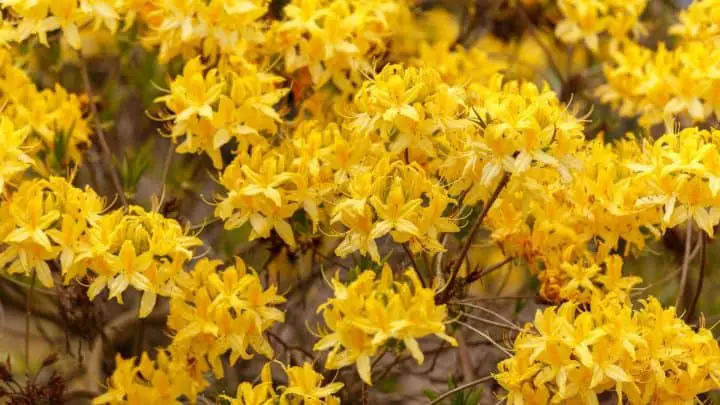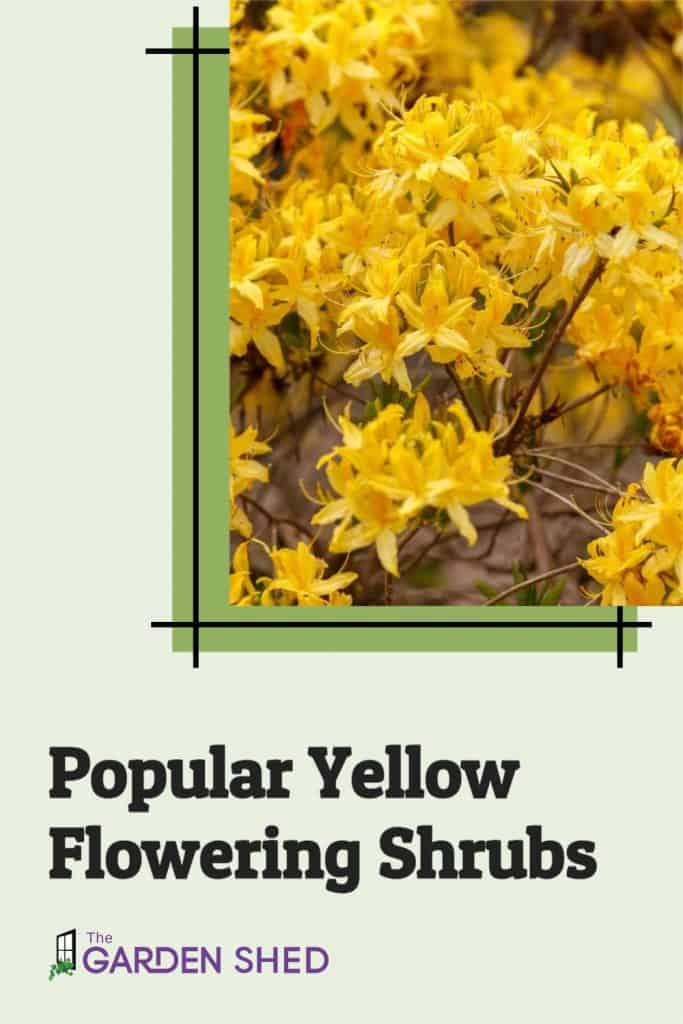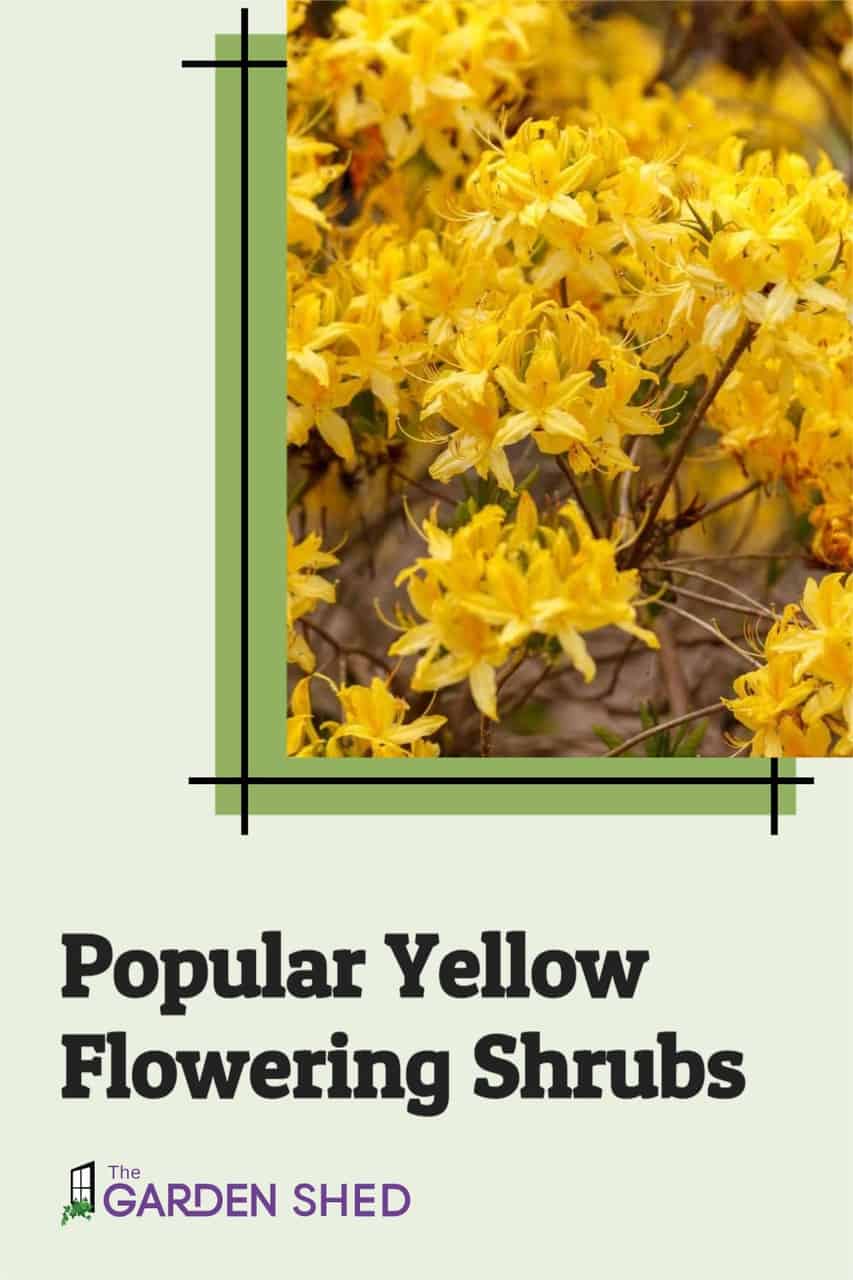Popular Yellow Flowering Shrubs

Yellow flowering shrubs are not only attractive in your yard or garden, but also attract pollinators such as birds, bees, and butterflies. Many of these shrubs flower in the spring, creating a pleasant and colorful start to the new year. If you are looking for yellow flowering shrubs, here are some of the most popular.
Azaleas and Rhododendron
Azaleas and Rhododendrons are often confused because they have similar flowers and they both bloom in the spring. Rhododendron is actually a group of plants with common characteristics. Azaleas are one of the plants in the Rhododendron family. Both azaleas and rhododendrons are available in a variety of colors, including yellow. Typically, rhododendrons are larger than azaleas. The leaves of the rhododendron are leathery and large. In comparison, Azaleas have smaller leaves.
Rhododendrons are evergreen, which means they hold their leaves through the winter. Azaleas are deciduous plants that lose their leaves every autumn. The one exception is the Japanese Azalea which is an evergreen plant.
Depending on the variety, azaleas and rhododendron do well in full sun or shade. All do best in moist and well-drained soil. USDA zones vary depending upon type, but most fall between zones 4 and 10.
Camellia Shrub
The pretty camellia shrub produces pale yellow flowers with interesting overlapping petals. They are not tolerant of extreme cold or heat and grow best in USDA zones 8 to 10. Camellias are popular in warmer regions such as the southeast United States. The dark green leaves are slightly shiny and the shape of the flowers is reminiscent of roses. Besides yellow, camellia shrubs are also available in pink, red, and white.
Camellia shrubs are popular ornamental shrubs. They are highly-prized for their pretty and sweetly fragrant flowers.
Forsythia
The pretty yellow forsythia is one of the most well known yellow flowering shrubs. It is always a happy harbinger of spring and one of the most welcome sights of the season. Depending on the variety, forsythia grows from 3 to 9 feet tall. The bright yellow blooms of this deciduous shrub appear in early spring before the leaves. Each arching branch is full of bright yellow flowers and, as a result, puts on quite a display in spring.
It grows best in USDA zones 4 to 8 and requires little maintenance. Forsythia grows best under full sun in well drained soil. It has a relatively short bloom time of a couple of weeks. Due to its size and and somewhat unruly growth, the forsythia is best suited as a border plant behind smaller plants in relaxed gardens. To encourage new growth, prune back after flowering.
Interestingly, the forsythia is named after William Forsyth (1737-1804), a Scottish botanist who was royal head gardener and founding member of the Royal Horticultural Society.
Japanese Rose
These pretty yellow flowering shrubs has flowers that resemble chrysanthemums. The Japanese rose has single flowers or double flowers. Both types bloom in spring and do best in zones 4 to 9. It often reblooms in the summer. The bright green stems retain their color throughout the winter season.
The Japanese rose does well in partial shade. It will do alright in full sun but the flowers will fade quickly. The Japanese rose tolerates a wide variety of soils as long as it is well-drained. It works well as an informal hedge and in woodland gardens.
Oregon Grape Holly
Also called mahonia, the Oregon grape holly is a favorite in the northwest United States. It is a tough flowering shrub with dark evergreen foliage and bright yellow spring flowers. In the fall, it produces clusters of deep blue fruits. The berries are edible but quite tart. It is resistant to deer, and the berries attract birds.
The Oregon grape holly grows between 3 and 8 feet tall and wide, and does best in USDA zones 6 to 9. It thrives in part shade to full sun in moist and well-drained soil. It works well as a border or privacy shrub due to its dense nature.
Potentilla
Also called shrubby cinquefoil or bush cinquefoil, the potentilla is a popular and long-blooming bush. It is tolerant of cold weather and relatively carefree. The potentilla grows best in zones USDA zones 2 to 7 in a full sun location. These popular yellow flowering shrubs are quite tough and, once established in well-drained soil, are drought tolerant. Depending on the variety, it grows to between 1 to 4 feet tall and just as wide.
These versatile yellow flowering shrubs are used in a variety of ways. They work great as hedges, at the back of borders, along slopes, or as a pretty addition to the rock garden. Birds, bees, butterflies, and other pollinators flock to the yellow blooms.
Rose Bush
Rose bushes have a reputation as being finicky, high maintenance plants, but the modern varieties are surprisingly easy to grow. Fortunately, there are a variety of modern rose bushes with yellow blooms. Most grow on woody thorny stems. Some varieties, such as the popular Knock Out roses, bloom repeatedly through the growing season, are low-maintenance, and disease resistance. They work well in borders, in mass plantings, or in cottage gardens.
In addition, many varieties of rose bushes are very fragrant and, as such, are magnets for pollinators. They require permeable, moist soil and full sun. They do best in USDA zones 3 to 9. Depending on variety, they range from 3 to 6 feet tall.
St. John’s Wort
Some varieties of St. John’s Wort are invasive, so choose wisely and plant in a strategic location. In size, these yellow flowering shrubs ranges from 3 to 9 feet tall and about 5 feet wide. The pretty yellow blossoms are a showy addition to the garden.
This plant does best in full sun to part shade and requires moist, well-drained soil. It will, however, tolerate rocky and sandy soils. St. John’s Wort does best in USDA zones 5 to 9.
Thryallis
The thryallis is much-prized for its long blooming season and pretty tropical looking flowers. It is a sub-tropical plant and, as a result, grows in just a few places in the United States. It is a low-maintenance plant and produces year-round blooms. The South Florida Plant Guide website claims the thryallis is one of the very easiest yellow blooming shrubs to grow.
The thryallis is a zone 10 and 11 plant and grows in southern Florida, parts of Arizona, the southern tip of Texas, and along the coast of California. It does well in full sun and is drought tolerant. It is a popular ornamental shrub and is deer resistant. This pretty shrub can be pruned as a topiary or left natural and used as a border plant. Left unpruned, the thryallis can grow as large as 9 feet tall and 6 feet wide.
Witch Hazel
Witch hazel is among the first shrubs to bloom in climates with cold winters, often making an appearance even before the forsythia. Fully grown, witch hazel can reach a height of 30 feet tall and 15 feet wide. Fortunately, it is a slow-growing plant and does not reach maturity for 20 years. The unusual and fragrant blossoms are yellowish-orange and resemble a curly ribbon.
Witch hazel does best in full sun to partial shade in USDA zones 3 to 9. It enjoys loamy, slightly acidic soil. Pruning will increase flowering.
Great Combinations for Yellow Flowering Shrubs
Like all plants with yellow blooms, yellow flowering shrubs look great when combined with plants that have white and purple blooms. Keeping this in mind, plant your shrubs near flowers or other flowering shrubs with white and/or purple blossoms for the most impact.
Related posts:
- Best White Flowering Shrubs
- Different Types of Hydrangeas
- Azalea Pruning and Care
- Flowers That Attract Bees to Your Garden

